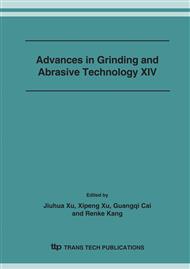p.513
p.518
p.523
p.528
p.533
p.538
p.543
p.548
p.554
Experiment on Dynamics of the Hybrid Polishing Kinematics Machine Tool with Clearance Based on the Flexible Multi-Body Systems
Abstract:
This paper develops a novel five DOF hybrid polishing kinematics machine tool in order to obtain more stable machining result in the elastic polishing on the free-form surfaces. Because the machine tool is a complex multi-body system that comprises many close-loop structures, jointing clearance becomes the important influence factor to its moving stability. The unified rigid multi-body and flexible multi-body dynamics equation of for the parallel mechanism of hybrid polishing kinematics machine tool is respectively built, which considers the influence of joint with clearance and applies the kinematics model of Newton second state. The result of analysis shows that the moving stability of the hybrid polishing kinematics machine tool is reduced due to the existing jointing clearance. However, the interior flexibility of the mechanism can reduce the shock effect of collision in the part of motion pair. It can improve the working stability of mechanism.
Info:
Periodical:
Pages:
533-537
Citation:
Online since:
November 2007
Authors:
Price:
Сopyright:
© 2008 Trans Tech Publications Ltd. All Rights Reserved
Share:
Citation:


